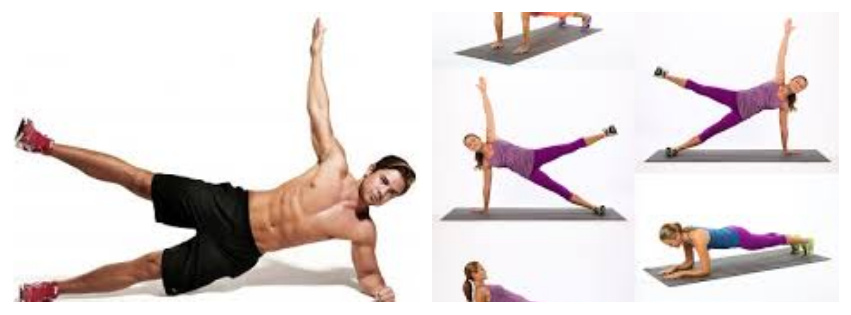Sure, holding a straight line isnt as exciting as bicycle crunches -but itll make you more functional both in the gym and out. Side planks are all about strengthening the side body and stabilizing your spine, says Cara Bonney, CSCS, a Master Trainer in Dallas. That translates to being able to lift more-whether its a barbell or a kid.
And if you think side planks are boring, well, you clearly havent tried the endless number of side plank variations.
How to do a side plank
Lay on your side with your forearm flat on the floor, bottom elbow lined up directly under your shoulder and both legs extended out in a long line. Feet can either be staggered for more stability, or stacked for more of a challenge. Engage your core and lift your hips off the floor, forming a straight line from your head to your feet. You should feel the abdominal draw in and cinch the waist feeling like a belt is lifting your waist/hips towards the ceiling, Bonney explains. Hold here for 15 to 30 seconds.
Top hand can be on side of hip (easier) or reaching up to the ceiling (harder). Keep your head in line with the spine and avoid looking down, which could compromise your cervical spine, Bonney says.
To make it easier, start with both knees bent, feet 90 degrees behind you, so youre forming a straight line from head to knees, and lift and hold. Then, one step up in difficult would be to keep the bottom leg bent but extend the top leg out, actively engaging the inner thigh as you push the top leg into the floor.
To make it harder, come into the regular side plank, but when you raise and hold, lift the top leg up and down or sweep it forward and back for more glute engagement. You can also add a challenge by dipping your hips toward the floor and back up.
The most advanced version: Start on your hand rather than your forearm, with your palm directly below your shoulder, top hand extended out toward the ceiling. Once you lift, rotate the top arm under the body, threading the needle and piking the hips slightly, then come back to neutral and repeat.
Most importantly, in all versions, avoid sinking into the shoulder-you should feel like youre pushing away from the floor at all times, Bonney says.
And stick to that 30 second max on all variations-if you want more of a burn, lower, pause, and then repeat. I would rather clients do a few shorter planks with great form than hold for minutes and start sinking into the hips and shoulders, Bonney says.
Benefits Of Side Planks
Side planks work your entire core. The core is not just the abdominals but include all trunk muscles including hips and back erector spinal muscles, Bonney explains.
It primarily uses the oblique abdominal muscles, but your gluteus medius and gluteus maximus-the side and back hip muscles-help stabilize the hip and shoulder stabilizers also keep you in alignment, Bonney says.
This is a great exercise to enhance movement in body daily life and other sports, Bonney says. It works our postural muscles-thats the spine and hips-to help us stay upright and prevent injuries, she adds.
One huge perk of this move is its super safe even for people who have back or disc injuries. While a lot of core moves involve curling your spine and putting pressure on your low back or neck (think: sit ups, bicycle crunches), side planks dont flex or compress your spine in any way. This not only reduces irritation and injury risk, but also enhances functionality since we move our body in daily life with a neutral spine position, Bonney points out.
How To Incorporate Side Planks Into Your Workout
Because its such a great and safe stabilizer, you should try and lift into side planks as many days of the week as you can-at least every time you exercise, Bonney advises.
Incorporate them at the beginning or end of a cardio day, or as a rest interval during interval training to make the most of every minute but still allow your heart rate come back to normal.
Like Bonney said, rather than holding a single side plank for a long time, opt for multiples in sets of 15 to 30 seconds. If you want a strong side burn or are working obliques today, start with the beginner side plank (knees bent), then add a couple variations in the next plank.
Her favorite way to work them into a routine: around the world planks. Start with a low plank (face down), then turn into a side plank, then flip up into a reverse plank, and then move into the other side plank. Hold each for 15 to 30 seconds, then go around the world again if your core is up for it.
